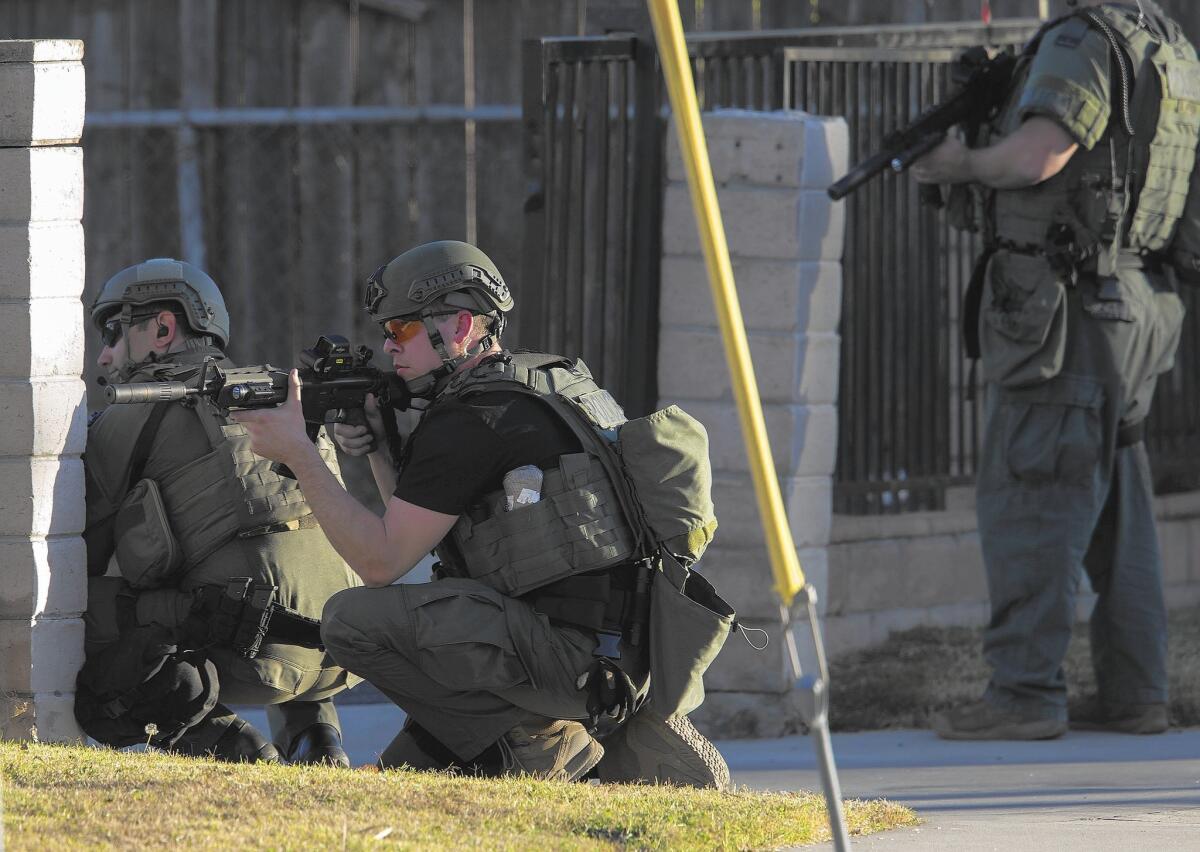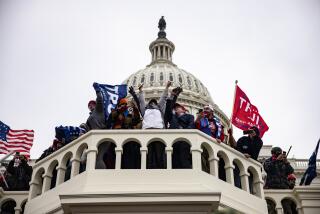Frequency of mass shootings paradoxically boosts public’s sensitivity — and resignation

There has been a threefold rise in mass shootings in the U.S. since 2011, a study found. Above, SWAT officers surround a home while searching for suspects in the mass shooting in San Bernardino.
- Share via
Attackers with long guns and body armor storm a holiday party at the Inland Regional Center in San Bernardino, and what follows is a routine that has become so commonplace as to be predictable.
Word of the shootings spreads quickly over Twitter and other social media. Hashtags: activeshooter, sanbernardino and 2ndamendment.
People around the world respond by switching on television sets to see live overhead pictures of mayhem and tragedy, scenes that are being repeated at an alarming rate in the United States: Emergency vehicles parked askew, lights flashing. Bloodied victims on streets and stretchers. EMTs scurrying. Police officers with revolvers in hand and SWAT teams arriving in armored vehicles.
Loved ones collapsing in grief.
Soon a smartphone video will emerge. This time, it was taken by a nurse at the facility, showing law enforcement running around the building. As it is broadcast on the networks, elected leaders are responding to the attacks with well-practiced language.
Conservatives offer condolences and praise for law enforcement, and liberals add calls for gun control.
“Praying for the victims, their families & the San Bernardino first responders in the wake of this tragic shooting,” tweets Jeb Bush.
“Good luck to law enforcement and God bless,” writes Donald Trump. “This is when our police are so appreciated!”
Hillary Clinton: “I refuse to accept this as normal. We must take action to stop gun violence now.”
Bernie Sanders: “Mass shootings are becoming an almost-everyday occurrence in this country. This sickening and senseless gun violence must stop.”
The victims are mind-numbing in their innocence — community college students in Roseburg, Ore.; parishioners in Charleston, S.C.; soldiers at a recruiting center in Chattanooga, Tenn.; the children at Sandy Hook Elementary School in Connecticut.
Yet their deaths have become routine, so much so that our language has changed.
On social media, the talk is of “active shooters” and “AK-47s” and “body armor,” all terms rarely heard outside of military and police circles a generation ago but common in an age when everyone can be a reporter or commentator.
J. Reid Meloy, a forensic psychologist in San Diego who consults on threat assessment for schools and corporations, said that the repetitive nature of the shootings paradoxically caused people to become both sensitive to them and inured to them.
“When you have an event that is happening frequently, people will resign themselves to the recurrence of the event,” Meloy said.
The result is hypersensitivity to personal safety and an acceptance when it happens to others.
A study by the Harvard School of Public Health and Northeastern University documents a threefold rise in mass shootings in the United States since 2011, leaving some experts to wonder whether the attention paid to each incident only encouraged copycats.
“One of the reasons I would cite for why we are seeing more now: We have the impact of social media and the mass publicity,” said Jeffrey Simon, a visiting lecturer at UCLA and author of “Lone Wolf Terrorism: Understanding the Growing Threat.” “That encourages people who want to go out in a blaze of glory.”
Ron Astor, a USC professor who has studied violence for more than 30 years, sees a nation that is failing its victims — those dead and those who will die in the future.
“Mass shootings are blended together into mass murder, and what is missing is a moral response,” Astor said.
Motivated by mental illness, racial hatred, religious fervor or merely a grudge, shooters bring a terrible justification to their violence that Astor worries is becoming accepted as a new normal.
Follow live coverage of the San Bernardino shooting >>
Killing is understood as a method for spreading a particular message, and the message is only reinforced by the attention that it receives.
Breaking this cycle requires a broader understanding of its causes and a new way to frame the discussion, Astor said.
“The killing of innocent people is treated as a tragedy, but until we focus on the victims themselves, we will not summon up the moral outrage that we need to condemn this violence,” he said.
“It’s not the language that we use but the language that we don’t use,” Astor said. “It is not enough to say these actions are crazy. What needs to be addressed is the sanctity of human life.”
As he and others observed, the underlying message of the violence Wednesday is clear: Mass shootings have created a disquiet that is all too familiar — and all too easily dismissed.
MORE ON SAN BERNARDINO SHOOTING
Maps track what happened and where in today’s shooting
‘Oh, my God! There’s a shooting!’ Life or death moment at Inland Regional Center
The U.S. infatuation with guns is bordering on a society-wide suicidal impulse
More to Read
Sign up for Essential California
The most important California stories and recommendations in your inbox every morning.
You may occasionally receive promotional content from the Los Angeles Times.












